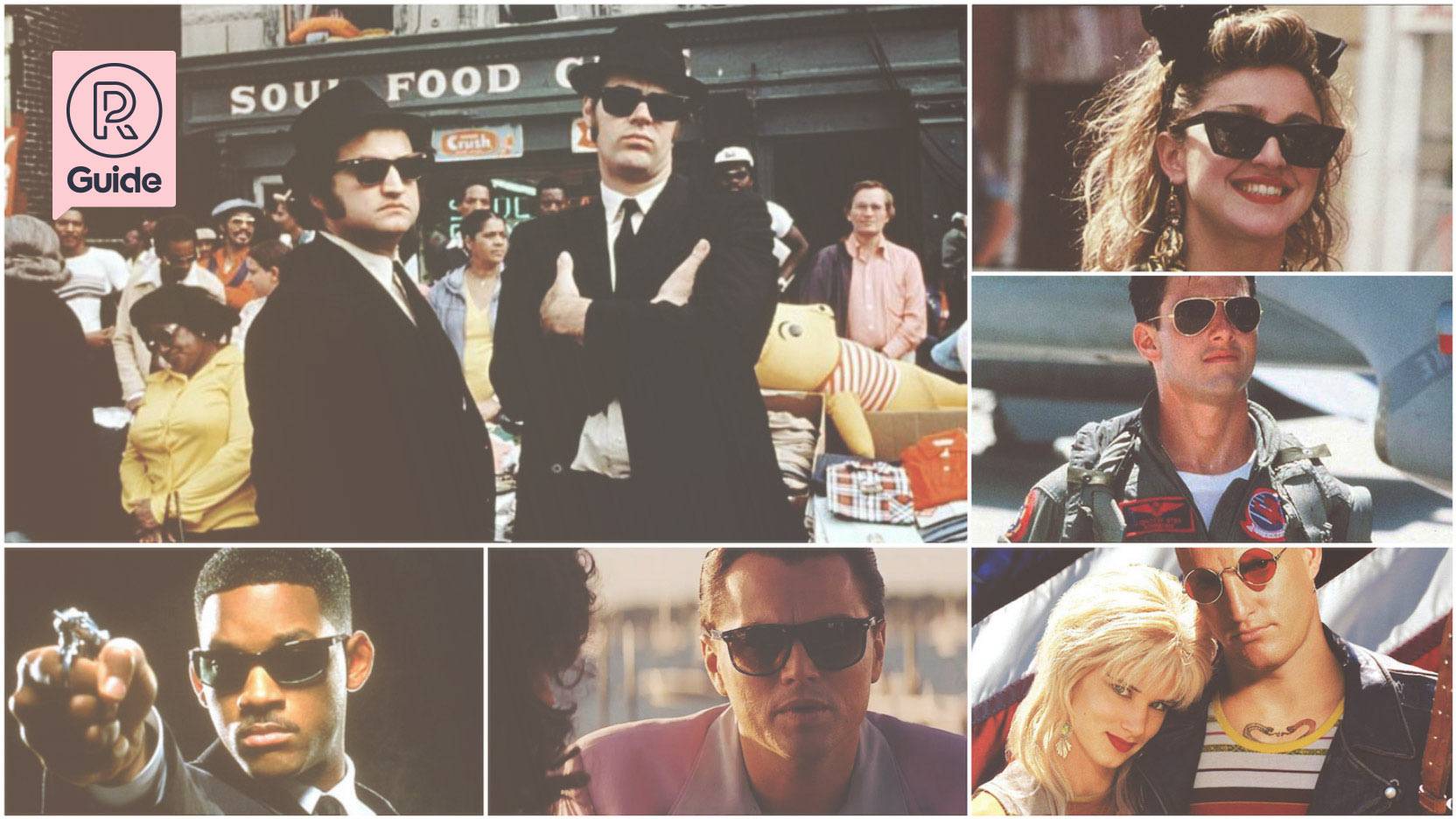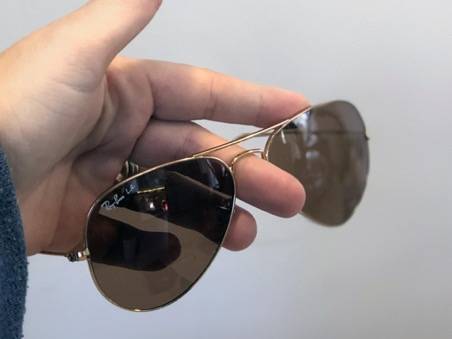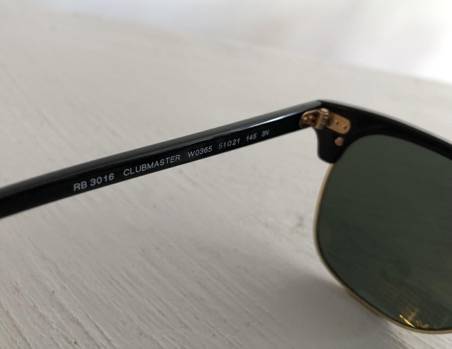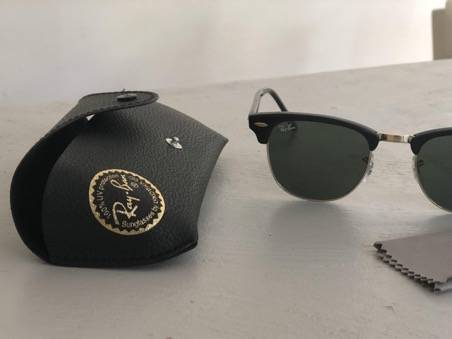Updated
Sunglasses: Picking Your Perfect Pair of Ray-Bans
Ray-Ban is the world's most favoured sunglasses brand. From classic pilot sunglasses like the Aviator models to the sophisticated Wayfarer models that elevate practically any outfit, we'll walk you through various models and give you tips on finding the right size and maintaining your sunglasses.

Never underestimate the power of a trendy pair of sunglasses. Not only do they elevate your style, but they also protect your eyes from harmful UV rays. Some even improve your vision by offering superior clarity and contrast through their lenses. Ray-Ban is nowadays a household name in the sunglasses industry with iconic models like the Wayfarer, Aviator and Clubmaster.
Most popular models

Ray-Ban Wayfarer
The iconic Wayfarer model was launched by Ray-Ban in 1952 and quickly became a must-have accessory among the elite in the 60s. Celebrities like Bob Dylan, The Beatles and Muhammad Ali were often spotted sporting these shades. The 70s saw a decline in the popularity, with only 20,000 pairs sold in 1980. But the 80s brought a comeback, thanks to Wayfarers being featured in popular films and TV series like Blues Brothers, Miami Vice and The Breakfast Club. This led to a sales boom in 1985, with 1.5 million pairs sold, and the model has remained popular since.

Ray-Ban Round Metal Classic
Think John Lennon! Round sunglasses weren't only a staple in the late 60s and early 70s. They made a big comeback in the 90s, embraced by the rave-loving youth and pop culture icons like Woody Harrelson in Oliver Stone's cult classic Natural Born Killers. Whether you're going for a hippie vibe or riding the wave of the 90s fashion, the Round Metal Classics are a solid choice for sun protection.

Ray-Ban Predator 2
Fancy channeling your inner action hero? If so, check the Ray-Ban's Predator 2 model–the name alone echoes an action cinema vibe. Cemented in pop-culture fame as the sunglasses Will Smith sported in the '90s blockbuster Men in Black, these shades will elevate your style game. So, even if you're not planning on fighting aliens or erasing people's memories with a "neuraliser", you can still look like that's your night time hobby with these sunglasses!

Ray-Ban Clubmaster
A few years following the Wayfarer debut, Ray-Ban released the Clubmaster–a blend of the Aviator and Wayfarer styles. Even these are classics in their own right–you maybe remember them from films like Reservoir Dogs, Ferris Bueller's Day Off and Malcolm X. The frames have a distinct top arch and free bottom lenses, giving off a retro, relaxed vibe.

Ray-Ban Aviator Classic
Ray-Ban started its journey in 1937 with the iconic Aviator model, featuring green G-15 lenses designed for American fighter pilots. Pilot sunglasses gained mass popularity when General Douglas MacArthur sported them post-WW2. But their fame peaked when Tom Cruise wore them in the 1986 hit Top Gun. So, wearing a pair of Aviators is like wearing a piece of Ray-Ban's history! These pilot sunglasses go well with just about any style or look.
There's a vast range of Ray-Ban models available today. Other popular designs include styles like the Meteor, Round and Caravan models.
Finding your Ray-Ban size and fit
Finding the correct frame size is super important when shopping for Ray-Bans. If you're making an online purchase, read through the product description to find the right size. And if you're in-store, check the frame for size details or ask a store attendant for help.
The size numbers on sunglasses frames can read as, for example, 50-20-150 or just 58-14.
The first number (50 or 58 in our example) represents the lens width. The second number (like 20 or 14) refers to the bridge width, the part that sits on your nose. The final number (like 150) is the arm length, which keeps the sunglasses on your head and extends just behind your ears. This last number doesn't apply to all sunglasses models.
As a rule of thumb in eyewear, size 50 suits people with narrower faces, while those with wider faces would do well with size 60. Size 55 usually fits most adult faces. These sizes represent the estimated millimetre size of the lens.
Still, it's worth noting that Ray-Ban states size 58 as the standard size, based on the average size most customers (a whopping 90%) purchase. The idea is simple—if it fits the majority of shoppers, it's likely to fit you too.
A handy tip to figure out the best size for your face is to check the size details on other sunglasses you own. You'll find size details on the frame of your sunglasses.
Ray-Ban also offers Frame Advisor Technology to help you find the best style based on your face size, shape and features.
How it works:
- Do a quick face scan to analyse your face shape, size and features.
- Complete your profile details and select your favourite sunglasses style.
- See how the styles fit you with the virtual try-on. The recommended size and style are determined by the measurements and shape of your face.
When it comes to sunglasses, figuring out sizes and dimensions isn’t always straight forward. It can be just as chic to sport oversized sunglasses. So, use the size as a guide, but don't shy away from trying on different styles to land the ideal pair that complements your look.

Types of lenses
Ray-Ban models feature a diverse range of lens colours and categories. Here's a snapshot of a few common types and what makes each unique:
- Classic lenses. Ray-Ban's original classic lenses get their name from the brand's debut 1937 models. Initially designed for fighter pilots, these single-shade lenses, especially the green G-15 variant, absorb 85% of visible light.
- Polarised lenses. These lenses are designed to reduce glare from reflective objects, like chrome, glass or water surfaces. Besides reducing glare, these lenses also enhance visual contrast.
- Mirrored lenses. These lenses feature a mirror effect, reflecting light to protect your eyes. Plus, they hide your eyes from the outside.
- Gradient lenses. These lenses feature a single colour surface at the top that gradually transitions to a different colour at the bottom.
- Flash lenses. These lenses are similar to polarised lenses but feature slightly more vivid colours. They also have the same function as polarised lenses–reducing glare and improving contrast.
- Premium lenses. For those craving a touch of luxury, there are lenses plated with 18 carat gold.
For all available options, visit Ray-Ban's official website.
Changing Ray-Ban lenses
Lenses can get scratched or damaged–sometimes, it's more practical to change lenses rather than invest in a new pair of sunglasses. To change your Ray-Ban lenses for frames you own, drop them off at the closest optometrist. Chances are they already offer Ray-Bans in their range and have lenses suitable for your frames.
If you're unsure about the model, you can always check its name on the inner side of the frame arms. The model name typically starts with "RB", followed by 4 digits. Look these up on Ray-Ban's official website to verify your model. As an example, RB3509 is a model from Ray-Ban's Active Collection.
An optometrist can fine-tune frames that have lost their original fit. If you take your Ray-Bans back to the optometrist you purchased them from, this adjustment often comes free of charge.
 Check the inside of the frame arm for the model name and size.
Check the inside of the frame arm for the model name and size.

Who owns the Ray-Ban brand?
The Ray-Ban brand is currently owned by Luxottica Group S.p.A., an Italian eyewear conglomerate headquartered in Milan, known as the world's largest eyewear company. Originally, Ray-Ban was an American brand owned by Bausch & Lomb.